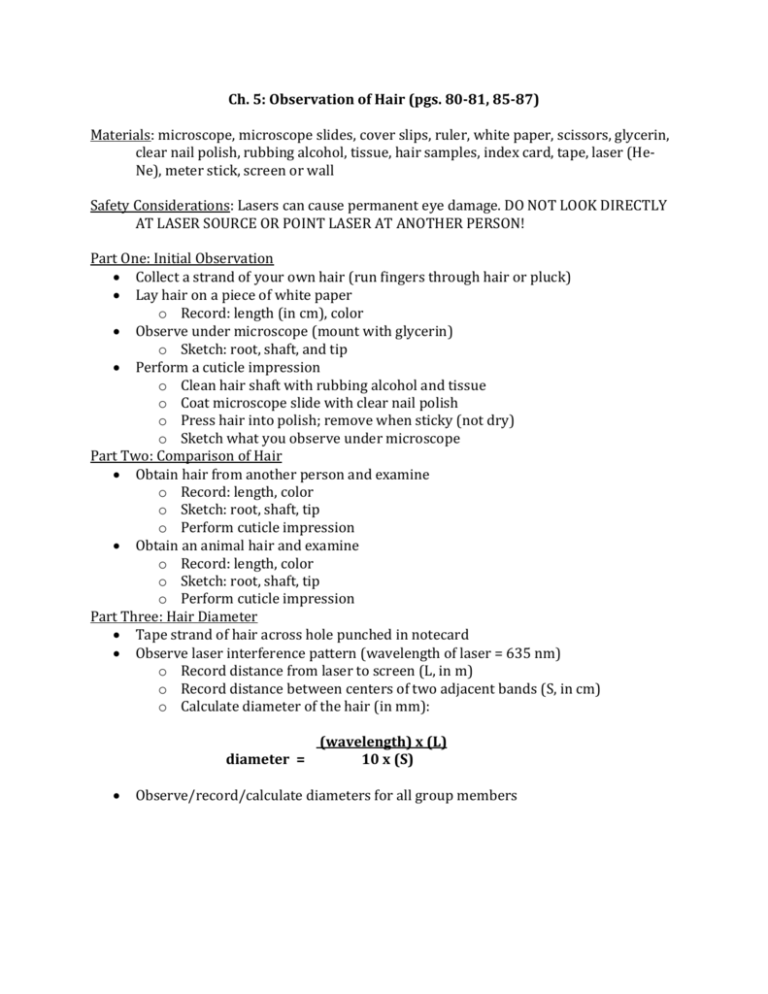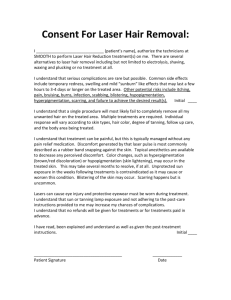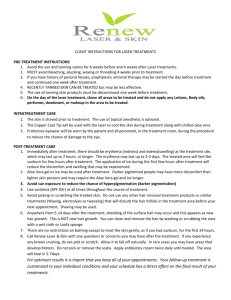Observation of Hair - Westford Academy Forensics
advertisement

Ch. 5: Observation of Hair (pgs. 80-81, 85-87) Materials: microscope, microscope slides, cover slips, ruler, white paper, scissors, glycerin, clear nail polish, rubbing alcohol, tissue, hair samples, index card, tape, laser (HeNe), meter stick, screen or wall Safety Considerations: Lasers can cause permanent eye damage. DO NOT LOOK DIRECTLY AT LASER SOURCE OR POINT LASER AT ANOTHER PERSON! Part One: Initial Observation Collect a strand of your own hair (run fingers through hair or pluck) Lay hair on a piece of white paper o Record: length (in cm), color Observe under microscope (mount with glycerin) o Sketch: root, shaft, and tip Perform a cuticle impression o Clean hair shaft with rubbing alcohol and tissue o Coat microscope slide with clear nail polish o Press hair into polish; remove when sticky (not dry) o Sketch what you observe under microscope Part Two: Comparison of Hair Obtain hair from another person and examine o Record: length, color o Sketch: root, shaft, tip o Perform cuticle impression Obtain an animal hair and examine o Record: length, color o Sketch: root, shaft, tip o Perform cuticle impression Part Three: Hair Diameter Tape strand of hair across hole punched in notecard Observe laser interference pattern (wavelength of laser = 635 nm) o Record distance from laser to screen (L, in m) o Record distance between centers of two adjacent bands (S, in cm) o Calculate diameter of the hair (in mm): (wavelength) x (L) diameter = 10 x (S) Observe/record/calculate diameters for all group members Sample: Length: Color: Sample: Length: Color: Magnification: Sample: Length: Color: Magnification: Sample: Length: Color: Magnification: Sample: Length: Color: Magnification: Sample: Length: Color: Magnification: Magnification: Sample: Length: Color: Sample: Length: Color: Magnification: Sample: Length: Color: Magnification: Sample: Length: Color: Magnification: Sample: Length: Color: Magnification: Sample: Length: Color: Magnification: Magnification: Laser Interference Hair Diameter Measurements and Calculations: (wavelength) x (L) diameter = 10 x (S) Wavelength of He-Ne laser = 635nm Hair Source (Group Member’s Name) Hair Texture (fine, medium, or coarse) Distance: laser to screen (L), in METERS Distance: center to center of adjacent bands (S), in CENTIMETERS Calculated diameter, in MICROMETERS (1mm = 1000μm) Analysis Questions: 1. What aspects of hair morphology were you able to observe under the microscope? 2. What differences did you see between different samples of human hair? 3. What differences did you see between human and animal hair? 4. Can you make any correlation between hair texture and diameter?







